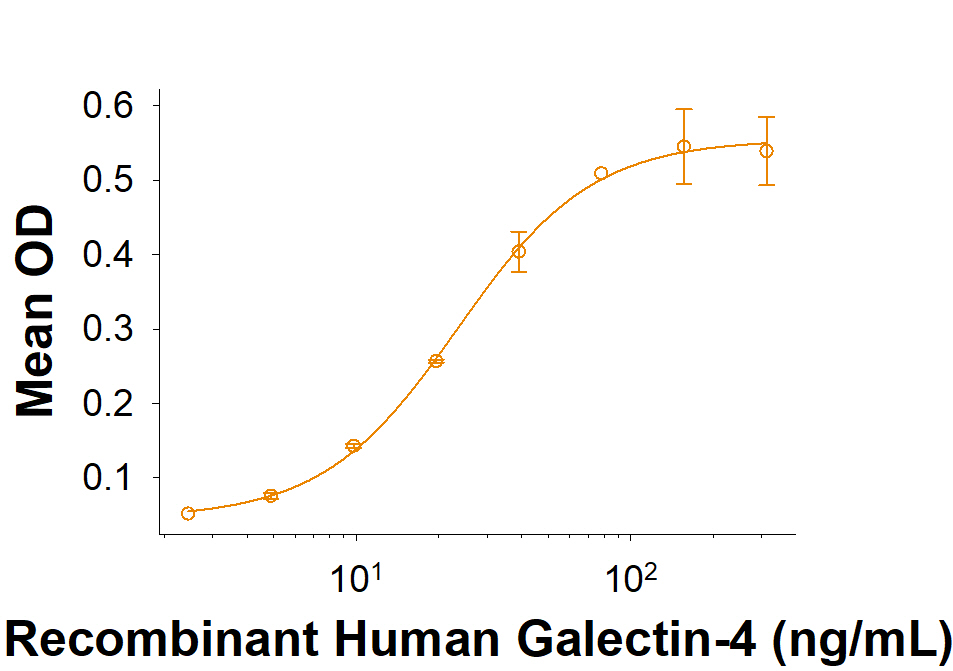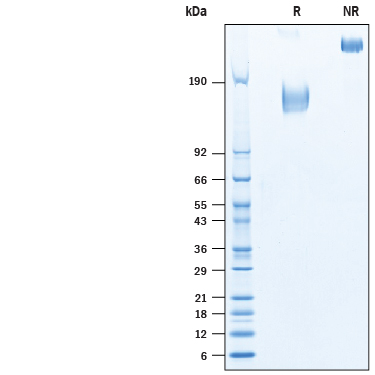Recombinant Human CEACAM-5/CD66e Fc Chimera Protein, CF
Recombinant Human CEACAM-5/CD66e Fc Chimera Protein, CF Summary
Product Specifications
| Human CEACAM-5/CD66e (Lys35-Ala685) Accession # NP_004354.3 | IEGRMD | Human IgG1 (Pro100-Lys330) |
| N-terminus | C-terminus | |
Analysis
Product Datasheets
Carrier Free
CF stands for Carrier Free (CF). We typically add Bovine Serum Albumin (BSA) as a carrier protein to our recombinant proteins. Adding a carrier protein enhances protein stability, increases shelf-life, and allows the recombinant protein to be stored at a more dilute concentration. The carrier free version does not contain BSA.
In general, we advise purchasing the recombinant protein with BSA for use in cell or tissue culture, or as an ELISA standard. In contrast, the carrier free protein is recommended for applications, in which the presence of BSA could interfere.
10449-CM
| Formulation | Lyophilized from a 0.2 μm filtered solution in PBS. |
| Reconstitution | Reconstitute at 400 μg/mL in PBS. |
| Shipping | The product is shipped at ambient temperature. Upon receipt, store it immediately at the temperature recommended below. |
| Stability & Storage: | Use a manual defrost freezer and avoid repeated freeze-thaw cycles.
|
Scientific Data
 View Larger
View Larger
 View Larger
View Larger
2 μg/lane of Recombinant Human CEACAM-5/CD66e Fc Chimera Protein (Catalog # 10449-CM) was resolved with SDS-PAGE under reducing (R) and non-reducing (NR) conditions and visualized by Coomassie® Blue staining, showing bands at 135-175 kDa and 270-330 kDa, respectively.
Reconstitution Calculator
Background: CEACAM-5/CD66e
CEACAM-5, also known as CEA, CD66e and Psg30, belongs to the large family of CEACAM and pregnancy specific glycoproteins. CEACAM family members are highly glycosylated with varying arrangements of IgV-like and IgC-like regions in their extracellular domains (ECD) and can be expressed as transmembrane, glycophosphatidyl inositol (GPI) linked or soluble proteins (1-3). CEACAM-5 consists of an N-terminal Ig-like V-set domain followed by six Ig-like C2-set domains and a GPI anchor (2, 4, 5). While the mature ECD of human CEACAM-5 shares 26% amino acid identity with mouse CEACAM-5, it remains unclear if these molecules are direct orthologs (6). CEACAM-5, expressed primarily by epithelial cells, functions as a calcium-independent adhesion molecule through homophilic and heterophilic interactions with CEACAM-1 (1, 7). CEACAM-5 is restricted to the apical face of intestinal epithelial cells in the adult but is more diffuse during embryonic development and in tumors (8). This is consistent with a role in the development and maintenance of epithelial architecture. CEACAM-5 is up-regulated in a wide variety of human tumors, promoting tumor cell migration, invasion, adhesion, and metastasis, and has been used as a cancer marker (8, 9). It also contributes to tumor formation by maintaining cellular proliferation in the presence of differentiation stimuli, and by blocking apoptosis following loss of ECM anchorage (anoikis) (10, 11). The GPI anchoring of CEACAM-5 can be released by GPI-PLD, resulting in a soluble molecule that also promotes tumor metastasis (12). Cell surface expression of CEACAM-5 on tumor cells prevents the adhesion of CEACAM-1 expressing NK cells and provides protection from NK-mediated lysis (8). CEACAM-5 was shown to bind galectin-4 and by surface plasmon resonance and coimmunoprecipitated with galectin-4 in human colon adenocarcinoma LS174T cell lysates (13). CEACAM-5 also binds a subset of Neisseria opacity proteins (Opa) and E. coli adhesion proteins (14, 15). These interactions trigger clustering of the lipid raft-localized CEACAM-5 to sites of pathogen contact (15, 16).
- Zebhauser, R. et al. (2005) Genomics 86:566.
- Hammarstrom, S. (1999) Semin. Cancer Biol. 9:67.
- Chan, et al. (2007) Curr Oncol. 14:70.
- Schrewe, H. et al. (1990) Mol. Cell. Biol. 10:2738.
- Hefta, S.A. et al. (1988) Proc. Natl. Acad. Sci. 85:4648.
- Hance, K.W. et al. Mutat Res. (2005) 576:132.
- Stern, N. et al. (2005) J. Immunol. 174:6692.
- Beauchemin N. et al. (2013) Cancer Metastasis Rev. 32:3.
- Blumenthal, R.D. et al. (2005) Cancer Res. 65:8809.
- Screaton, R.A. et al. (1997) J. Cell Biol. 137:939.
- Ordonez, C. et al. (2000) Cancer Res. 60:3419.
- Yamamoto, Y. et al. (2005) Biochem. Biophys. Res. Commun. 333:223.
- Ideo, H. et al. (2005) J Biol Chem. 280:4730.
- Martin, J.N. et al. (2016) Biochemistry. 55:4286.
- Berger, C.N. et al. (2004) Mol. Microbiol. 52:963.
- Tchoupa, A.K. et al. (2014) Cell Commun Signal. 12:27.
FAQs
No product specific FAQs exist for this product, however you may
View all Proteins and Enzyme FAQsReviews for Recombinant Human CEACAM-5/CD66e Fc Chimera Protein, CF
There are currently no reviews for this product. Be the first to review Recombinant Human CEACAM-5/CD66e Fc Chimera Protein, CF and earn rewards!
Have you used Recombinant Human CEACAM-5/CD66e Fc Chimera Protein, CF?
Submit a review and receive an Amazon gift card.
$25/€18/£15/$25CAN/¥75 Yuan/¥1250 Yen for a review with an image
$10/€7/£6/$10 CAD/¥70 Yuan/¥1110 Yen for a review without an image

